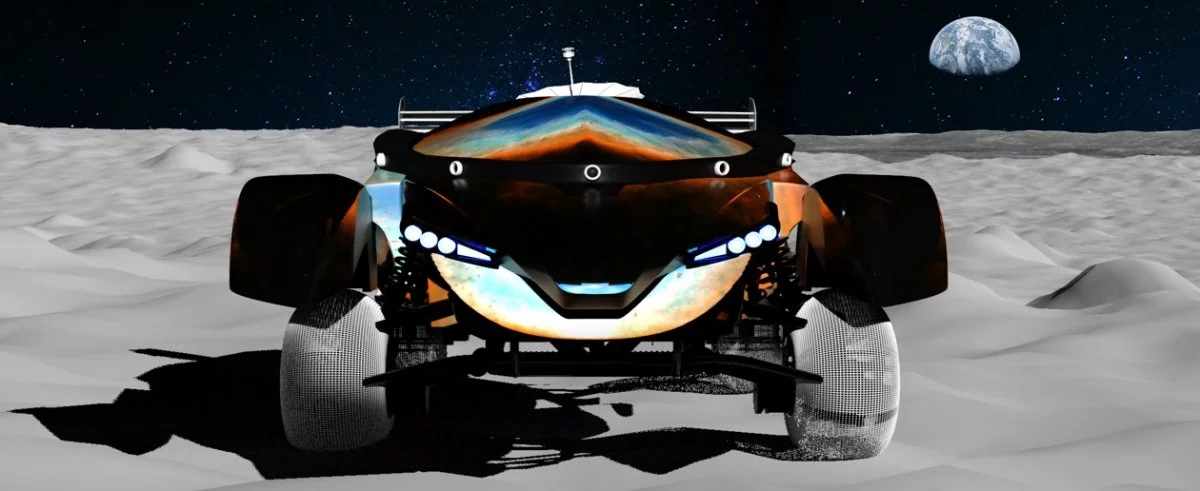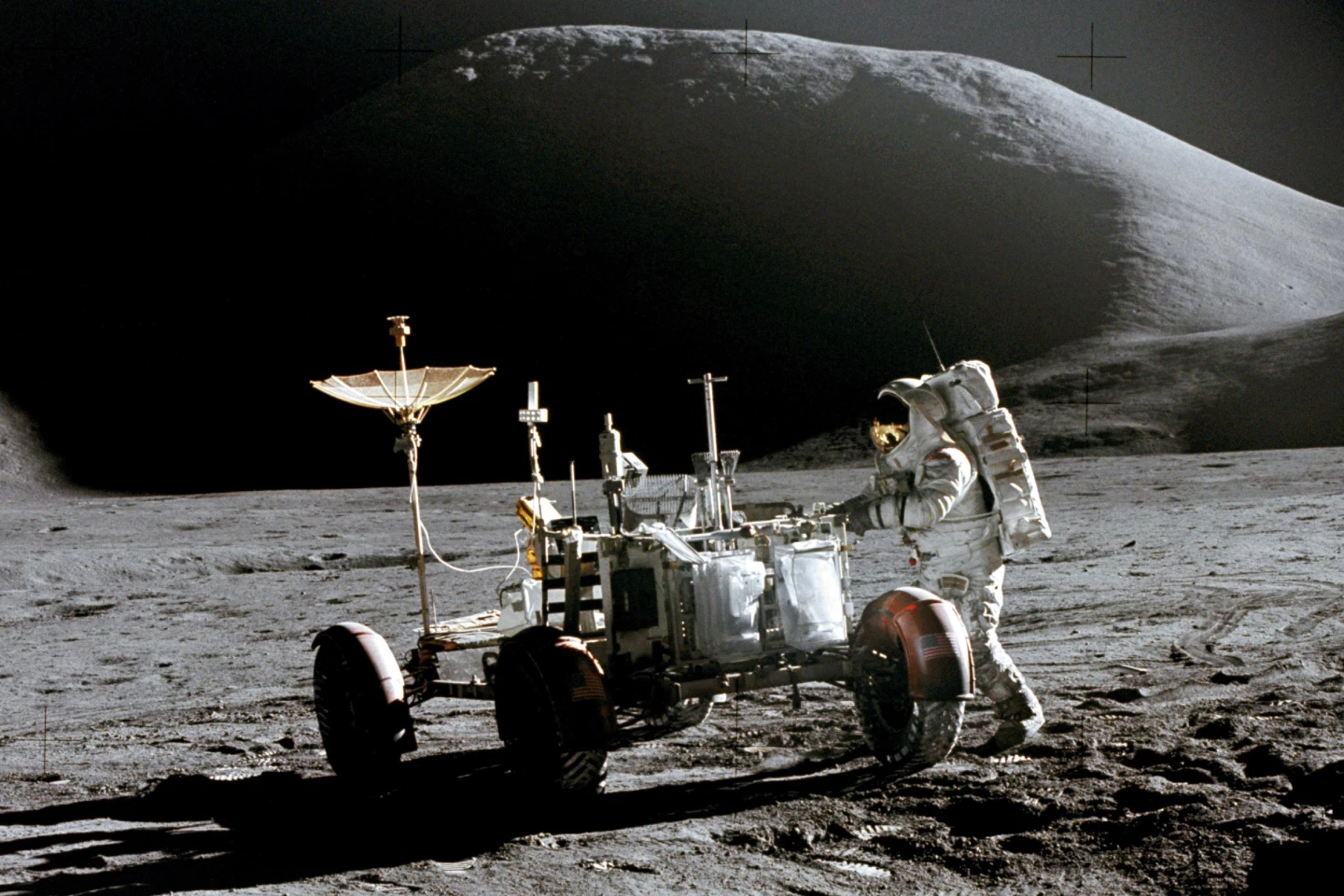An extremely odd project is planning to hold a remote-controlled car race next October ... On the surface of the Moon. What's more, the two racecars will be partially designed by high school kids, and McLaren P1 designer Frank Stephenson is involved.
Each car will weigh 2.5 kg (5.5 lb), and the "deployment mechanism" used to deposit them on the lunar surface will weigh a further 3 kg (6.6 lb.) This 8 kg (17.6 lb) combined weight is a big deal, because it's going to the Moon. That's somewhat of a special delivery, and not a cheap one. Lunar logistics company Astrobotic, for example, is currently quoting prices of US$1.2 million per kilogram (around US$544,000 per pound) to plonk things down in one of its Peregrine lander modules.
These Moon Mark racecars, however, will not be traveling with Astrobotic. They'll be traveling in a Nova-C lander made by Intuitive Machines, which will be sent spaceward on the top of a SpaceX Falcon 9 rocket with an anticipated launch date in October 2021. The "first lunar lander wholly developed by a private company," the Nova-C will touch down in the Oceanus Procellarum, close to the grand canyon-sized Schröter’s Valley, and its chief task is conduct an initial survey of the area.
Now imagine that thing landing and disgorging its entire 100 kg of meticulously prepared payload, and imagine a full 8 percent of that payload, possibly more, being taken up by a pair of remote-control cars whose chief purpose is to race each other around the place in a live-streamed entertainment event to make science and technology entertainment more fun for high school kids ... The whole thing blows my mind.
Still, strange as it is, a race there will be! "Moon Mark’s Mission 1 competition will include six diverse teams of high school students selected from across the United States," reads a press release, "who will compete in a series of qualifying challenges that include unique demands, such as drone and autonomous vehicle racing, e-gaming, and a space commercialization entrepreneurship contest. The two top teams from the qualifying rounds will win a once-in-a-lifetime opportunity to build and race two vehicles on the Moon. The vehicles will be loaded onto Intuitive Machines’ Nova-C Lunar Lander, launched from Earth on SpaceX’s Falcon 9 rocket, and land in 2021. Competitors will then race their rovers remotely, navigating through harsh terrain, racing around a sphere of cameras, which will capture every aspect."
Naturally, we had questions for the Moon Mark team, the first of which was: what's the control and vision latency going to be like for humans driving these things from Earth? How will the signal be sent?
Moon Mark CTO Todd Wallach responded: "We do not expect significant communications delay as impacting the race or drivability of the vehicles. We will have near real time visuals, telemetry and command and control via our partnership with Intuitive Machines. The racers built by Lunar Outpost will connect with the Intuitive Machines Lander via WiFi, and the Lander will send and receive telemetry, commands and controls to and from the Earth to drive the racers. "

I'm a little dicey on this one. If communications proceed between Earth and the Moon at the speed of light, which it's fair to say is pretty fast, they'll take about 1.3 seconds to cover the 384,000-odd kilometer (238,600 mile) gap. So unless there's some weird quantum entanglement business going on, the absolute best case scenario seems to be that when these kids push a thumbstick here on Earth, it'll take 1.3 seconds for the car to do something on the Moon, and 2.6 seconds before anything happens on the video feed they're watching.
This does not strike me as a recipe for inch-perfect apex hunting. On the other hand, the Moon doesn't have a lot of native apexes. In fact, what the heck will they be racing around? "There's a track that's being designed," says automotive designer Frank Stephenson, who's in charge of the final race car designs. "They're designing a lunar circuit track. They know the lunar surface, it's been scanned to the point where he has enough information to develop this track."
This raises even more questions; if every kilogram you send up costs megabucks, how do you mark a track out? Clearly, you don't; it'll simply be a race between pre-planned co-ordinates chosen because they look from here like they're decently smooth and safe. And since the race will be over a totally rough and natural lunar surface, how can the racers be expected to dodge obstacles with a 2.6-second delay? Heck, how will these kids even know when to stop turning so they don't end up pointed in entirely the wrong direction?
And it's not like they're planning to go slow. "Our racers will be designed to test the limits of speed on the lunar surface," Moon Mark Founder and CEO Mary Hagy tells us. "The checkered flag remains the deciding factor upon which the final winner will be determined." Indeed, the team is planning suspension development around the assumption that these things will be getting airborne – well, spaceborne – off inclines and debris. Then again, you probably don't need to go that fast to get off the ground when the gravity's only about 1/6th of what we're used to on Earth.
The two race cars will be based on the same basic architecture, which we understand is not yet locked down, but will include a battery-electric drivetrain. Moon Mark has partnered with Colorado's Lunar Outpost, which will take its Mobile Autonomous Prospecting Platform (MAPP) and adapt some of its capabilities to create the racing platform. You can see the MAPP in the video below.
Clearly, the race cars will be vastly different. For starters, the MAPP weighs 10 kg (22 lb) all by itself, and travels at a very un-racy 10 cm (3.9 inches) per second, which equates to 0.36 km/h (0.22 mph). A race that proceeds at the pace shown above wouldn't exactly be a white-knuckle watch – but hey, it'd solve the control latency issue!
The bodywork and look of the two cars will be different, and this is Stephenson's domain with the assistance of the winning high schoolers. "There's a lot of things they have to consider," says Stephenson. "Obviously it's not downforce! It's more about, say, dust filtration, traction, weight, materials, endurance, stability ... Then there's center of gravity, and protection – if these things flip over at speed, you have to make sure none of the parts are damaged. You have to be able to upright it in some way. But everything you do to these things adds weight, everything you do to correct something else is another part added. So there's got to be an incredible simplicity to the design, and incredible reliability. There's a pretty big team working on it, a huge engineering team and there's some huge names attached that will be announced in early 2021."
"These things have the capacity to look really cool," he continues. "If you look at the lunar rovers, they never look really cool. It might look cool from an engineer's point of view, but from a designer's point of view, you're always questioning why they haven't done this or that to give a little bit more of an edge to it. Obviously the body surfacing of these cars will be minimal; it's all weight. But you want the surfacing to work with the engineering, not just add pieces on to make it look cool. Smart engineering and smart design should go hand in hand, so the ambition is to make it look great and work well. This is a way to get the young generation involved in discovering new technology, and stretching their minds in a way that's never been done before in history."

Well this is true, and it seems like a huge team and extraordinary resources are being pulled together to make it happen. Really extraordinary resources; millions upon millions of dollars, to start with. So it's time to ask the tough questions: how does the team behind this project expect to get their money's worth for the enormous expense of sending these things to the Moon and back?
"Moon Mark is an entertainment and education company," says Hagy, "that will create and distribute content globally. We will capture and share the adventures of the next generation, as they compete to become the first students whose work lands on the Moon. Following the race itself, the vehicles will move into their scientific mission, remaining on the lunar surface indefinitely."
This whole thing is like a Russian doll of weirdness. Every part of this venture looks extraordinarily difficult and insanely expensive, with the ultimate outcome being some R/C car race footage filmed without the aid of a human cameraman to set things up, so there's every chance it'll look pretty ordinary. It sets my head spinning.
Since the Apollo era and a series of unmanned landers in the 1970s, humans have done surprisingly little on the lunar surface for the last 40-odd years. While there's been plenty of fly-bys, gravity slingshots and orbiters go past the Moon in recent years, and numerous other spacecraft have been deliberately crashed into the Moon at the end of their missions, only five spacecraft have attempted to actually land on the surface since 1978. And of those five, two crashed and failed just last year.
This Intuitive Machines mission will be one of six more landing attempts planned for 2021, but Moon missions are still vanishingly rare. I'd have operated under the assumption that cargo space aboard lunar landers would be reserved for cutting-edge scientific research equipment, and yet here we are looking at what might be the fourth lander to touch down on the Moon in 43 years, and a tenth of its cargo will be a pair of remote-controlled race cars.

It's bonkers. The whole thing is bonkers. Don't get me wrong, I'm a big fan of bonkers, as many of you know. The sheer scope and audacity of this project absolutely beggars belief, and perhaps the financial equation will make more sense once some of the heavy hitters behind it reveal themselves. But if SpaceX and the other private space flight companies truly manage to democratize space travel and squash the costs of these kinds of flights, maybe we'll see more and more weird ideas like this over the coming years.
There's something to be said for that. While the vast majority of Moon missions have been dry, scientific affairs, the ones that really captured the world's imagination were the first manned missions. Watching astronauts bounce around on that dusty, alien surface in a state of childlike wonder, on an astrological body so close we can see its craters, yet so impossibly far away – that sort of thing puts a human scale and an element of fun into the hard science of space, inspiring the hardest of hearts.
Maybe that's a worthwhile goal. Or maybe today's kids will consume the Moon Mark race like they do any other internet video, give it a quick thumbs up and get back to watching skateboard fails and cats that sound like they're talking. I guess time will tell!
Source: Moon Mark









